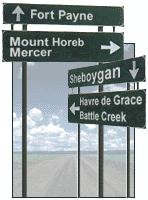Red, White, and Blue Highways

The story of the U.S. Interstate
by Ricco Villanueva Siasoco
 Related Links
External Links |
What could be more emblematic of America than the open road? From Jack Kerouac to Thelma and Louise, an unbroken expanse of land with a solitary road calls forth images of romantic waywardness and infinite grandeur. The United States' intricate system of highways links Portland to Pensacola, Pacific Coast to Atlantic, and cities and rural towns in between.
In the beginning of the 20th century, a national, uninterrupted system of highways was merely a pipe dream. A National Road was built in 1815 that ran between Maryland and St. Louis, and facilitated immigration to the central United States. This road, however, fell into disrepair.
First Attempt
The Federal-Aid Highway Act of 1938 was the first serious attempt to develop a national roadway system. Under the auspices of the Bureau of Public Roads, the goal of this act was to study the feasibility of a toll-financed system of three east-west and three north-south superhighways. From this study, officials found out this system could not be self-supporting. They advocated for a 26,700-mile network instead.
Interstate System Takes Shape
Congress passed further legislation in the form of the Federal-Aid Highway Act of 1944. The act chartered a "National System of Interstate Highways" and expanded the network to 40,000 miles. Soon state highway agencies and the Department of Defense planned nationwide routes. No specific funds were authorized for construction, however, making progress slow.
Eisenhower Makes It a Reality
Dwight Eisenhower had long realized the importance of highways, even before he became president in 1953. In 1919 as a young lieutenant colonel in the army he had accompanied the first transcontinental military motor convoy from Washington, DC, to San Francisco. Like most American motorists, the soldiers traveled on dirt roads and crumbling bridges; it took about two months for them to cross the country. And years later, during World War II, he observed the advantages of the German autobahn network, which made for safe and efficient mobility.
The Federal-Aid Highway Act of 1954 set aside $175 million for the construction of an interstate highway system. However, even more money was needed for the system that Eisenhower envisioned, and he continued to press for funds. Two years later, the expanded Federal-Aid Highway Act of 1956 authorized a budget of $25 billion, of which the federal share was to be 90%.
A Standard Design
The legislation of 1956 also provided for an extended netowrk of 66,000 km (41,012 mi) and nationwide design standards, including:
- a minimum of two lanes in each direction
- lanes that were 12 ft in width
- a ten-foot right paved shoulder
- design speeds of 50–70 mph
Further legislation over the years continued to expand the total length of the system, which now stretches for more than 75,198 km (46,726 mi). In 1990, in recognition of President Eisenhower's pivitol role in building the national system of interstate highways, President George Bush signed legislation officially renaming it the Dwight D. Eisenhower System of Interstate and Defense Highways.
Naming the Highways
The procedure for naming the highways is systematic. Major routes are designated by single- or two-digit numbers. If a route runs north-south, it is given an odd number, and if route a runs east-west, an even number. For north-south routes, numbering conventions begin in the west. Thus I-5 runs north and south along the West Coast, while I-95 runs north and south along the East Coast. For east-west routes, numbers begin in the south.
Major routes usually traverse cities and are the shortest and most direct line of travel. Connecting interstate routes that travel around a city carry three-digit numbers.







